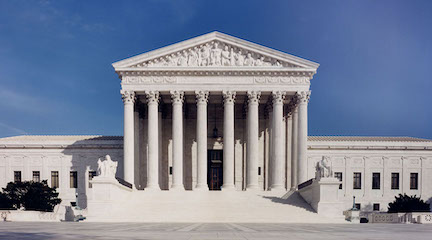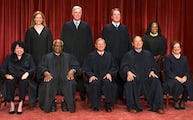Have a question you'd like answered in this FAQ? Email Professor George Watson.
What is the procedure for filling a vacancy on the Court?
Article 2 Section 2 of the Constitution specifies only that the president
". . . by and with the advice and consent of the Senate, shall appoint . .
. judges of the Supreme Court . . . ." In practice, when a Supreme Court
vacancy occurs, the president selects a nominee, whose name is forwarded to
the Senate for consideration, first by the Senate Judiciary Committee and
then by the whole Senate. That consideration ultimately involves a vote by
the Senate to confirm or deny the appointment. If more senators vote for
than against confirmation, the nominee is confirmed as a lifetime appointee
to the high Court. If the vote for confirmation fails to gain a simple majority
of the votes cast for and against the nominee, then the nominee is rejected
and the president submits another nomination.
For greater detail about the constitutional and the extra-constitutional
setting of the appointment process, see Watson and Stookey,
Shaping America: The Politics of Supreme Court Appointments, pp, 7-13.
Does the procedure for appointing the Chief Justice differ from that of a regular associate justice?
Not really. The Chief Justice position is essentially administrative,
very much a case of first among equals. That said, the Court bears the
moniker of the Chief Justice. At the moment, we have the Roberts Court.
The Chief Justice is the symbol of the Court, and that could conceivably affect senators'
criteria in their decision to confirm or reject.
Will the nomination of a new justice be political in nature?
Of course it will. Nominations are always political. It may be that the
president and the Senate will choose the subtler politics of consensus in
the selection and confirmation of a new nominee, which was President Clinton's
approach with his two nominees (Ginsburg and Breyer). On the other hand,
the president or those opposed to the president's nomination preferences may
choose to pursue the politics of controversy, but make no mistake it's all
politics. All of the appointments in the 21st century have resulted in substantial
opposition from the minority party. Check out the page dealing with the
Nomination Setting and any covering a specific nomination.
How many Supreme Court justices have been nominated since the beginning
of the Court? How many of these were confirmed?
This is a fairly straight forward question with a slightly tricky answer.
One complicating factor is nominations that are withdrawn. Take the
example of Chief Justice Roberts. Does his nomination to replace O'Connor, which was
withdrawn and subsequently resubmitted as the Rehnquist vacancy nomination count
as one or two nominations? I count it as one since no action was taken by the Senate.
On the other hand, President Jackson's nomination of Roger Taney to be an associate justice
was postponed by the Senate. Jackson subsequently nominated him to be Chief Justice.
This counts as two nominations. So, here is one set
of numbers, with the understanding that other people may count differently.
Number of nominations: 165 (includes Roberts once*)
Number of failed nominations (see next paragraph): 45
Number of confirmed who served: 120
Number who served but not confirmed: 1 (Rutledge was recess appointment by Washington, subsequently rejected by Senate)
Number of people serving as justices: 116 (counting once Hughes, E. White, Stone, and Rehnquist all of whom served
as associate justice before becoming Chief Justice and two of whom served nonconsecutive terms, Rutledge and Hughes)
Failed nominations may not be rejections by the Senate. Seven of these
45 were actually confirmed by the Senate but the person confirmed declined
the appointment. Another died between confirmation and taking the oath.
Quite a few were withdrawn or the Senate simply failed to act on the
nominations. In a couple of instances, a vacancy was declared not to
exist because of changes in the number of seats on the Court. Only 12
of these failed nominations came about as a result of a formal vote
of rejection in the Senate. See the Failed Nominations page for more detail.
Roberts is the 17th Chief Justice, although, again, one of these (Rutledge)
served on an interim appointment from George Washington before having
his nomination rejected by the Senate, so Roberts is only the 16th confirmed to the position.
*Roberts was first nominated to fill the vacancy created by Justice O'Connor's retirement, but when Chief Justice Rehnquist died,
President Bush nominated him to fill the Chief Justice vacancy.
Update by George Watson on October 25, 2022





